-
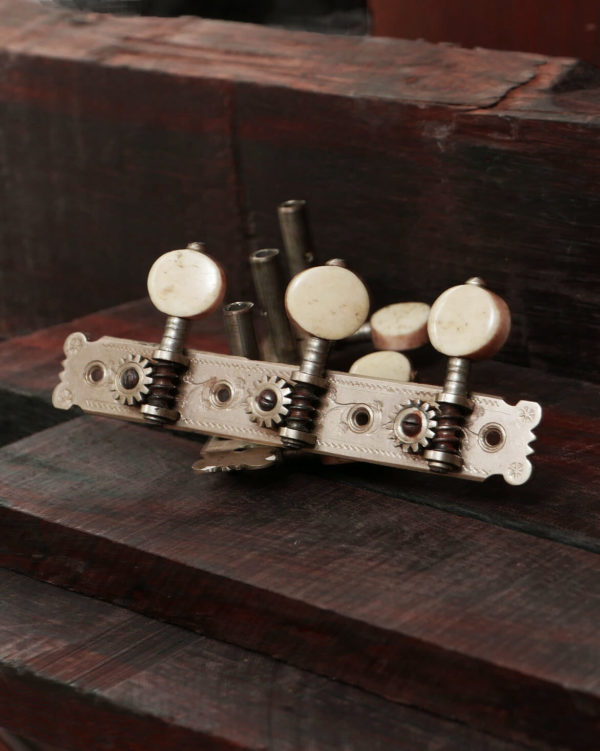 Rare set of Seidel Tuners. Seidel tuners, made in Germany in the 19th century, were CF Martin’s tuner of choice for his high-end guitars. You can see these tuners on some rare 1860 – 1880’s Martins– but they are very rare to encounter not married to a guitar. German silver backplates; floral pattern decorations, hand-engraved, The original buttons are of genuine bone. Good working order. Price: $1295.
Rare set of Seidel Tuners. Seidel tuners, made in Germany in the 19th century, were CF Martin’s tuner of choice for his high-end guitars. You can see these tuners on some rare 1860 – 1880’s Martins– but they are very rare to encounter not married to a guitar. German silver backplates; floral pattern decorations, hand-engraved, The original buttons are of genuine bone. Good working order. Price: $1295. -
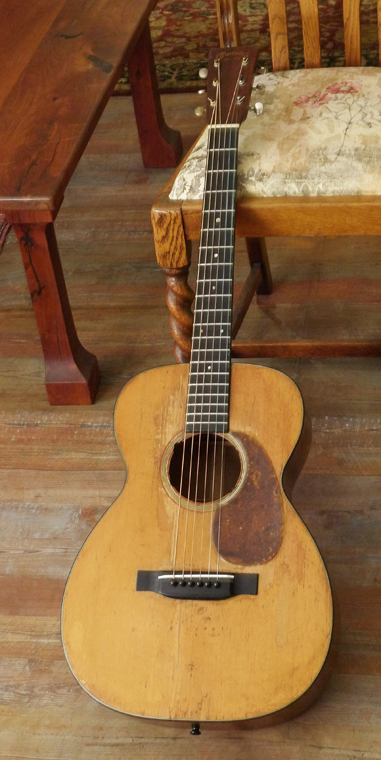 This guitar is probably among the first twenty Martins made in 1939 after the change in nut width on 14-fret models from 1 3/4" to 1 11/16", so yes it is 1 11/16. It has all original finish. Original tuners. Original maple bridge plate. It has multiple repaired cracks on top and sides (no cracks on back). Extensive play wear. New, but perfect, historically correct reproduction Ebony bridge.
This guitar is probably among the first twenty Martins made in 1939 after the change in nut width on 14-fret models from 1 3/4" to 1 11/16", so yes it is 1 11/16. It has all original finish. Original tuners. Original maple bridge plate. It has multiple repaired cracks on top and sides (no cracks on back). Extensive play wear. New, but perfect, historically correct reproduction Ebony bridge. -
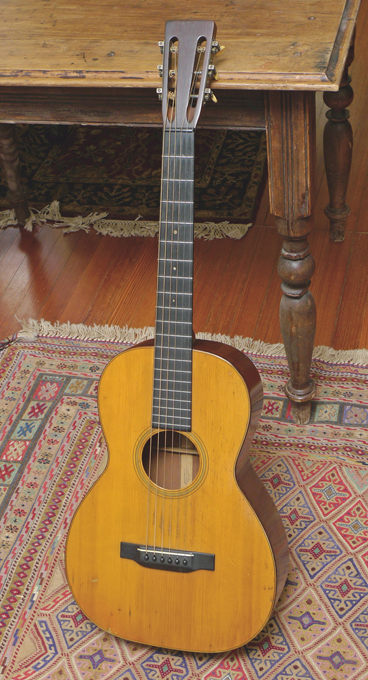 An all-original Martin from the finest era in the company’s history, this 0-18 is unsurpassed for Martin 12-fret Adirondack spruce over Mahogany tone. What can you add about a 1930 Martin, that is 100% original, down to the original bridge pins, and original ivory saddle This example is from the time when Martin had just started using belly bridges, and the ebony belly bridge on this guitar still has its original ivory saddle. And this guitar is 100% crack-free. Period. The instrument features the original bridge (full height), original tuners, original ivory saddle, original nut, and original maple bridge plate (the bridge plate shows almost no wear from ball ends–almost unheard of in a prewar Martin). All original finish– everywhere. Some honest playwear and various minor nicks and dings give the wonderfully aged and naturally honey-hued Adirondack top character. The top shows perfect form, with no bellying behind the bridge, etc. One of the things that makes Martin’s from these year so great-sounding: Martin was still using a thin ebony rod inside the neck, not a metal bar. So the instrument is more free to resonate, from tuners, right down to the bridge. And resonate this one does, with a strong bass especially that puts many many large size guitars to shame. 1-7/8 inch nut. The neck has just been set, by us, retaining the original Bar frets
An all-original Martin from the finest era in the company’s history, this 0-18 is unsurpassed for Martin 12-fret Adirondack spruce over Mahogany tone. What can you add about a 1930 Martin, that is 100% original, down to the original bridge pins, and original ivory saddle This example is from the time when Martin had just started using belly bridges, and the ebony belly bridge on this guitar still has its original ivory saddle. And this guitar is 100% crack-free. Period. The instrument features the original bridge (full height), original tuners, original ivory saddle, original nut, and original maple bridge plate (the bridge plate shows almost no wear from ball ends–almost unheard of in a prewar Martin). All original finish– everywhere. Some honest playwear and various minor nicks and dings give the wonderfully aged and naturally honey-hued Adirondack top character. The top shows perfect form, with no bellying behind the bridge, etc. One of the things that makes Martin’s from these year so great-sounding: Martin was still using a thin ebony rod inside the neck, not a metal bar. So the instrument is more free to resonate, from tuners, right down to the bridge. And resonate this one does, with a strong bass especially that puts many many large size guitars to shame. 1-7/8 inch nut. The neck has just been set, by us, retaining the original Bar frets -
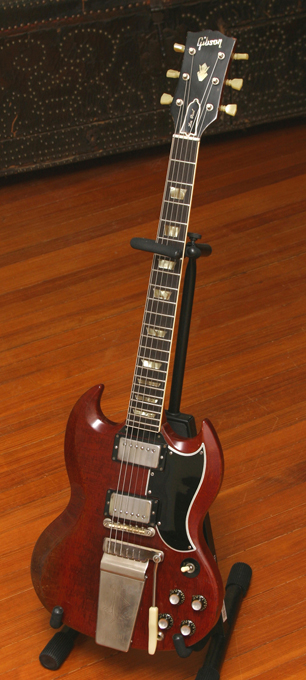 1963 and 1964 were the best years for the legendary early 60's Gibson SG. And 63-64 saw the transition from the Les Paul model to the "Solid Guitar" or SG. Only in 63 and 64 did Gibson use a particularly wide neck on the SG, and that's why players love SG's from these two seminal years. This '64 SG is something of a transition model from the last of the double cutaway Les Paul/SG's to the SG Standard-it carries the Les Paul truss rod cover (original to the guitar), and it features the great lyre vibrola (nickel). This 1964 SG, with all original finish, and original parts (including Patent # humbuckers), is a wonderful instrument with the right amount of honest wear to make it fit like a glove, and play like a dream in your left hand with that wonderful ample neck.
1963 and 1964 were the best years for the legendary early 60's Gibson SG. And 63-64 saw the transition from the Les Paul model to the "Solid Guitar" or SG. Only in 63 and 64 did Gibson use a particularly wide neck on the SG, and that's why players love SG's from these two seminal years. This '64 SG is something of a transition model from the last of the double cutaway Les Paul/SG's to the SG Standard-it carries the Les Paul truss rod cover (original to the guitar), and it features the great lyre vibrola (nickel). This 1964 SG, with all original finish, and original parts (including Patent # humbuckers), is a wonderful instrument with the right amount of honest wear to make it fit like a glove, and play like a dream in your left hand with that wonderful ample neck. -
Out of stock
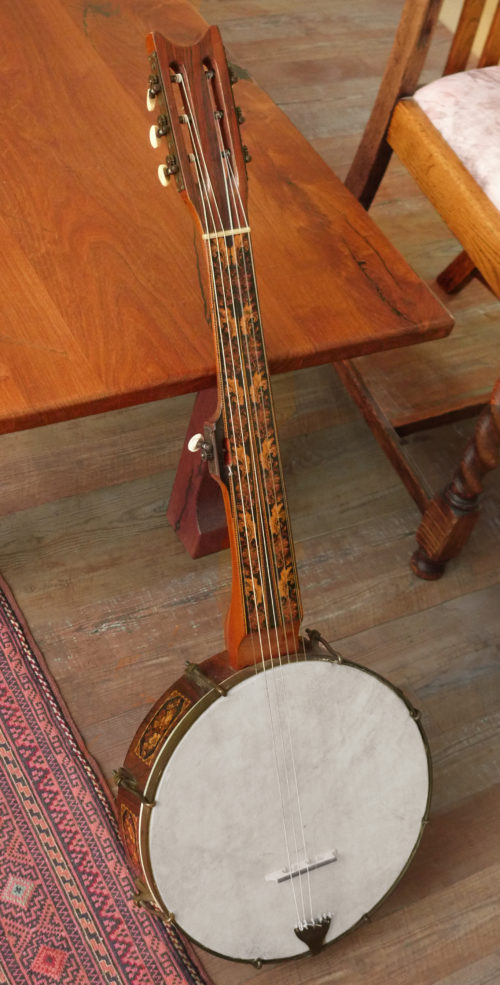 A rare and amazingly original English, Tunbridge ware fretless 7 string banjo. Circa 1850-60. This instrument is 100% original, and even the tailpiece is the original brass tailpiece. This banjo is also rare in that it has original geared tuning machines, not pegs like other examples from the period. The Tunbridge ware banjo is almost impossible to find in this condition and stage of originality. And Tunbridge’s are rare, period. The history? After Joel Sweeney – born to a farming family in Appomattox, Virginia and claimed to have learned to play the banjo from local African population, and the earliest known person to have played the banjo on stage – embarked on a European tour that included stops in London and Edinburgh. He played there for several months, and raised awareness of the instrument in England. As in the U.S., banjos began to be made by local craftsmen – they were still hand made and came in all shapes and sizes, with 5, 6, 7 and even 12 strings, and with one or more drone strings, sometimes on both sides of the neck. Only a few, best ones, such as this instrument, had an amazing amount of work put into them, none more so than those made by a very few firms centered around Tunbridge Wells in Kent, where the local craftsmen specialized in producing a particular form of Treen ware, made from up to 180 different colored woods. Holly, cherry, plum, yew, sycamore, and even imported lignum vitae were all used. The technique was to bind short lengths together and glue them into bundles so when viewed end on, a pattern or picture could be seen. Instrument length: 34 inches. With a 12 inch pot. Eight tensioners and shoes, all original. Original, rare circa 1850 German brass machine tuners (one bent shaft– but still operates perfectly). Original brass tailpiece. Fingerboard, and pot, consisting of inlaid woods as geometric patterns. All the inlays are intact. $2450. In a modern case.
A rare and amazingly original English, Tunbridge ware fretless 7 string banjo. Circa 1850-60. This instrument is 100% original, and even the tailpiece is the original brass tailpiece. This banjo is also rare in that it has original geared tuning machines, not pegs like other examples from the period. The Tunbridge ware banjo is almost impossible to find in this condition and stage of originality. And Tunbridge’s are rare, period. The history? After Joel Sweeney – born to a farming family in Appomattox, Virginia and claimed to have learned to play the banjo from local African population, and the earliest known person to have played the banjo on stage – embarked on a European tour that included stops in London and Edinburgh. He played there for several months, and raised awareness of the instrument in England. As in the U.S., banjos began to be made by local craftsmen – they were still hand made and came in all shapes and sizes, with 5, 6, 7 and even 12 strings, and with one or more drone strings, sometimes on both sides of the neck. Only a few, best ones, such as this instrument, had an amazing amount of work put into them, none more so than those made by a very few firms centered around Tunbridge Wells in Kent, where the local craftsmen specialized in producing a particular form of Treen ware, made from up to 180 different colored woods. Holly, cherry, plum, yew, sycamore, and even imported lignum vitae were all used. The technique was to bind short lengths together and glue them into bundles so when viewed end on, a pattern or picture could be seen. Instrument length: 34 inches. With a 12 inch pot. Eight tensioners and shoes, all original. Original, rare circa 1850 German brass machine tuners (one bent shaft– but still operates perfectly). Original brass tailpiece. Fingerboard, and pot, consisting of inlaid woods as geometric patterns. All the inlays are intact. $2450. In a modern case. -
Out of stock
 1957 Martin D-18 Guitar with Original Red Spruce Top Read the full description below. If you're interested in this guitar, please call 512.922.8596 or contact us here.
1957 Martin D-18 Guitar with Original Red Spruce Top Read the full description below. If you're interested in this guitar, please call 512.922.8596 or contact us here. -
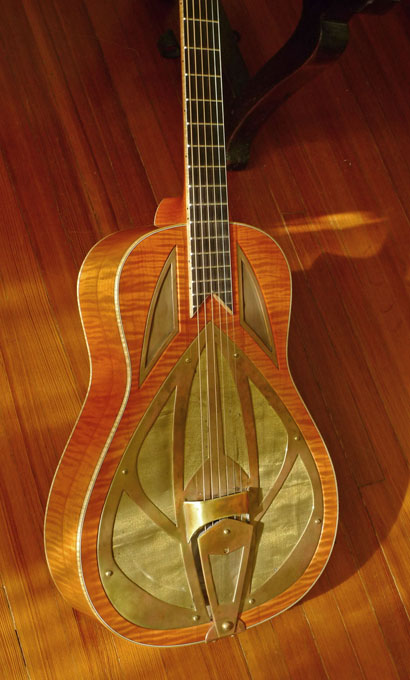 This stunningly beautiful, one-of-a-kind custom built resonator (from 2006, in beautiful crack-free condition and with only light wear) is from Tony Nobles, well-known luthier, and maker of instruments for Joe Walsh, Billy Gibbons and many other artists. The art deco ornamentation compliments an incredibly well built instrument, with meticulous attention to detail. Listen to/watch the video clip where guitar master Redd Volkaert put this instrument through some interesting jazz and blues paces.
This stunningly beautiful, one-of-a-kind custom built resonator (from 2006, in beautiful crack-free condition and with only light wear) is from Tony Nobles, well-known luthier, and maker of instruments for Joe Walsh, Billy Gibbons and many other artists. The art deco ornamentation compliments an incredibly well built instrument, with meticulous attention to detail. Listen to/watch the video clip where guitar master Redd Volkaert put this instrument through some interesting jazz and blues paces.- Spun-aluminum Quartermane biscuit-style cone (single-cone resonator)
- Solid curly maple, back top, and sides, with light tobaccoburst nitrocellulose lacquer finish
- Art deco coverplate, soundholes, and tailpiece of antiqued brass with a metal mesh covering
- Maple binding on body
- Custom torch inlay on headstock
- Curly maple neck
- Waverly tuners
- Scale: 24.4 inches
- Nut width: 1 7/8 inch
- String spacing at nut: 1 18/32
- Bridge spacing: 2 1/8
- Lower Bout: 14 1/2
- Upper bout: 9 1/2
- Body depth at bottom: 3 ¾ inches
- Body depth at neck joint: 3-20/32
-
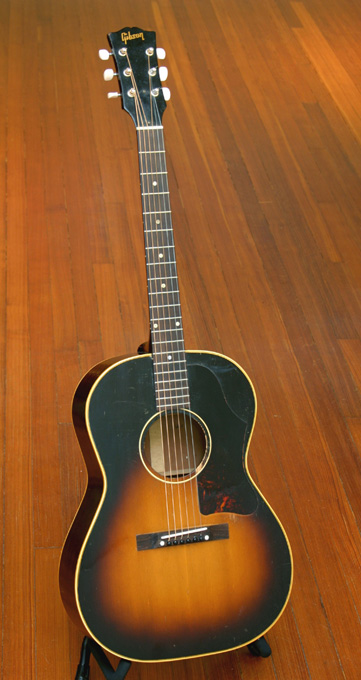 A wonderful, completely crack-free LG-2. The neck was recently set by Mark Erlewine, the frets dressed, and a new saddle installed ... beautifully set up by ME. 1-11/16 inch nut. Mahogany back and sides. Spruce top. Low action, with no buzzing. Nice sustain, and volume.
A wonderful, completely crack-free LG-2. The neck was recently set by Mark Erlewine, the frets dressed, and a new saddle installed ... beautifully set up by ME. 1-11/16 inch nut. Mahogany back and sides. Spruce top. Low action, with no buzzing. Nice sustain, and volume. -
Out of stock
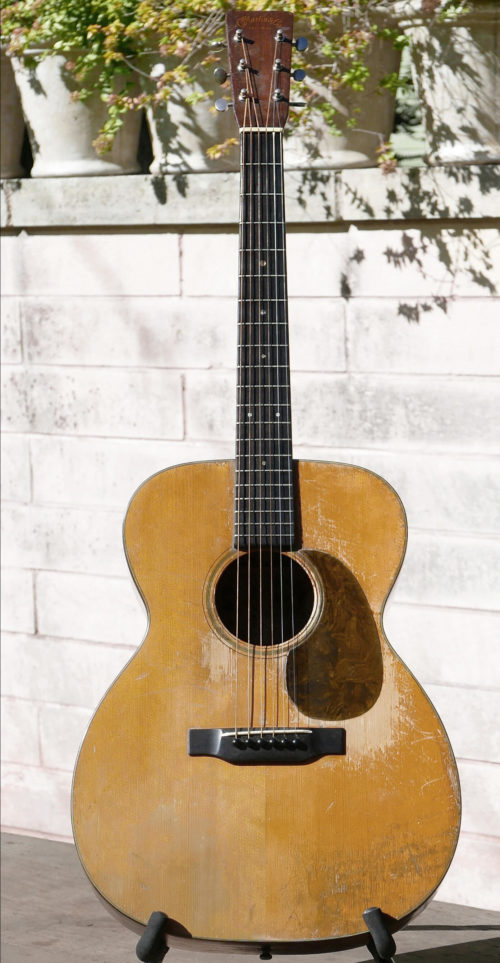 Impossible to mistake this guitar for a “1937 Authentic” or some such “recreation”. This 000-18 left the Martin factory in Nazareth, in 1937, indeed. And it’s been well-played since. More importantly, the tone is stellar– all you would expect from this style, this year, and more. Its bass response is similar to the best prewar D-18s. And it has the unmistakable string separation that only prewar Martins have. This instrument was in the family of its original owner until we obtained it. The original owner was Leroy Jenkins, a blind country artist in the 1950’s, in Texas, on the Dude label.
Impossible to mistake this guitar for a “1937 Authentic” or some such “recreation”. This 000-18 left the Martin factory in Nazareth, in 1937, indeed. And it’s been well-played since. More importantly, the tone is stellar– all you would expect from this style, this year, and more. Its bass response is similar to the best prewar D-18s. And it has the unmistakable string separation that only prewar Martins have. This instrument was in the family of its original owner until we obtained it. The original owner was Leroy Jenkins, a blind country artist in the 1950’s, in Texas, on the Dude label. -
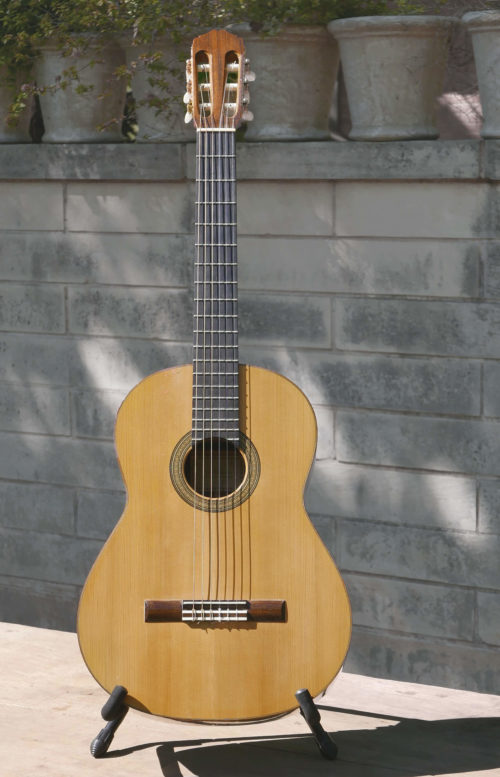 Tom Blackshear is a living legend in the classical and flamenco guitar worlds. He’s been building from his shop in Texas for decades, with an international client base and international prestige, and his older guitars especially are hard to find and in great demand (and rarely come to market. (There is currently one at Dream Guitars. This guitar was built in 1987, and was based on Jeffrey Elliott’s “1943 Hauser” plan. The tone is robust, and clear, with bright brazilian trebles, and the kind of nice string separation and clarity that an old German spruce top gives. The instrument:
Tom Blackshear is a living legend in the classical and flamenco guitar worlds. He’s been building from his shop in Texas for decades, with an international client base and international prestige, and his older guitars especially are hard to find and in great demand (and rarely come to market. (There is currently one at Dream Guitars. This guitar was built in 1987, and was based on Jeffrey Elliott’s “1943 Hauser” plan. The tone is robust, and clear, with bright brazilian trebles, and the kind of nice string separation and clarity that an old German spruce top gives. The instrument:- Tom Blackshear classical guitar, serial # 184, built in 1987; signed on label by the builder; also signed in pencil, on underside of top
- model: based on Jeffrey Elliott’s “1943 Hauser” plan
- Brazilian Rosewood back and sides
- German spruce top
- Brazilian Rosewood bridge
- Ebony fretboard
- Scale length: 660
-
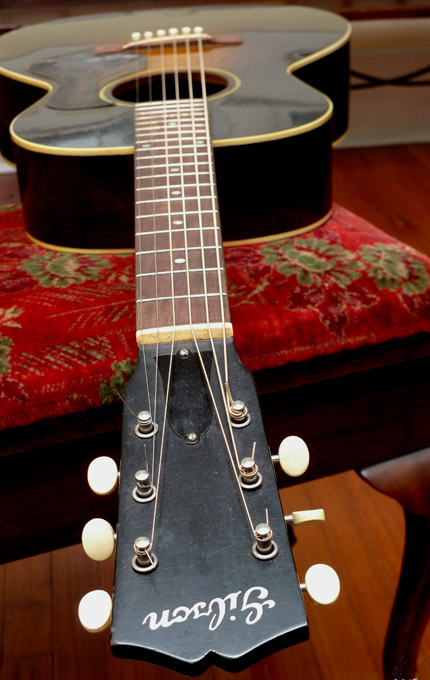 Crack-free, and 100% original, down to the bridge pins, and the original Geib case. Just getting a neck set to make it play perfectly.
Crack-free, and 100% original, down to the bridge pins, and the original Geib case. Just getting a neck set to make it play perfectly. -
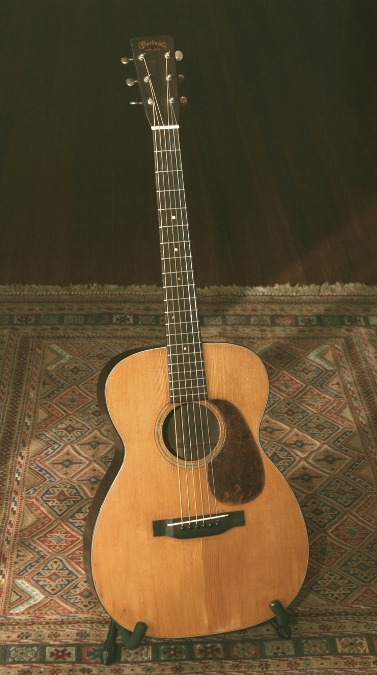 Probably the best year ever for 14-fret 00-18s. In the Golden Age of 14-fret Martins from the early 30's until the late 30's, only in 1936 did Martin use Brazilian rosewood (as opposed to ebony) for the fretboard and bridges of 18's, so its tone is considered by many to be the best in the 14 fret, 1-3/4 inch nut era. The guitar is crack-free on the top and back. Just one repaired crack on the treble side.The repair is well done and almost impossible to see from the outside (older repair has muslin cloth on inside-luthiers agree that these older cloth patches inside a vintage Martin should be left in place). Original tuners. Original bridge plate. Original nut. Replaced T-frets by us. Replacement bridge-very dark Brazilian rosewood bridge made to original specs in our shop, and ivory saddle. The neck has that wonderful mid-thirties slightly fatter profile. Neck set by us. And the tone is the best example of a Golden Era 00-18 you'll find anywhere. Light overspray (no refinishing) on back and sides (not top, neck or head).
Probably the best year ever for 14-fret 00-18s. In the Golden Age of 14-fret Martins from the early 30's until the late 30's, only in 1936 did Martin use Brazilian rosewood (as opposed to ebony) for the fretboard and bridges of 18's, so its tone is considered by many to be the best in the 14 fret, 1-3/4 inch nut era. The guitar is crack-free on the top and back. Just one repaired crack on the treble side.The repair is well done and almost impossible to see from the outside (older repair has muslin cloth on inside-luthiers agree that these older cloth patches inside a vintage Martin should be left in place). Original tuners. Original bridge plate. Original nut. Replaced T-frets by us. Replacement bridge-very dark Brazilian rosewood bridge made to original specs in our shop, and ivory saddle. The neck has that wonderful mid-thirties slightly fatter profile. Neck set by us. And the tone is the best example of a Golden Era 00-18 you'll find anywhere. Light overspray (no refinishing) on back and sides (not top, neck or head).